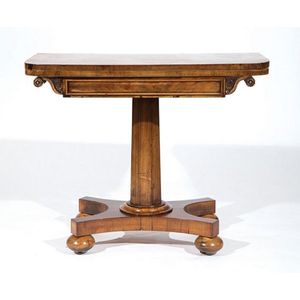Tasmanian Colonial Inlaid Occasional Table, c1835
You must be a subscriber, and be logged in to view price and dealer details.
Subscribe Now to view actual auction price for this item
When you subscribe, you have the option of setting the currency in which to display prices to $Au, $US, $NZ or Stg.
- Fiddleback - A name given to the pattern of the grain in some timbers, where the lines of the grain are compressed and at the same time wavy. Fiddleback grain is prized as a timber for furniture and musical instruments, and is expensive becasue of its scarcity.
In Australia fiddleback graining is found in blackwood. Other non-native timbers that are sometimes found with a fiddleback grain are mahogany and maple. - Blackwood - One of the best known and most widely used Australian timbers, blackwood (acacia melanoxylon), is a member of the Acacia (wattle) family and grows in eastern Australia from about Adelaide in South Australia, as far north as Cairns in Queensland.
The largest, straightest and tallest trees come from the wet forest and swamps of north-west Tasmania where it is grown commercially.
Blackwood timber colours range across a wide spectrum, from a very pale honey colour through to a dark chocolate with streaks of red tinge.
The hardwood timber has been commonly used in the production of furniture, flooring, and musical instruments in Australia from the late 19th century. However, the straight grain timber is not the most prized or valuable, that honour falls to blackwood with a wavy, fiddleback pattern, which is used both in the solid and as a veneer. Fiddleback was only used on the finest examples of furniture. - Musk Wood - The musk is native to Tasmania, and is found in the rainforests and wetter regions especially along river banks. It grows to a height of between five and fifteen metres, it has a musk scent. A rare timber and therefore mainly used as a veneer in the 19th-century, it is light brown in colour and furniture constructed from it is very expensive.
- Secondary Timbers - As indicated by the name, these are less expensive and thus lower quality timbers used in the construction of an item in surface areas that may not generally be seen, such as backboards, or as the ground for veneers, drawer linings or for framing.
- Huon Pine - Named after the Frenchman who discovered the Huon River in Tasmania, it is an extremely slow growing and long living tree. Huon pine is native to Tasmania, and it can grow to an age of 3,000 years or more. The wood contains oil that retards the growth of fungi, hence its early popularity in ship-building in convict-era Tasmania. The timber is a warm yellow colour, finely grained, and was popular for household furniture in the Victorian era. Interestingly, much Huon pine furniture was made in South Australia. Huon pine is a protected species and only limited quantities are available nowadays, for craftsmen to manufacture small items such as platters, sculptures and other decorative objects.
- Inlay - Decorative patterns inserted into the main body of a piece of furniture, generally in wood of contrasting colour and grain, though brass, ivory, ebony, shell and sometimes horn have been used. Inlay may consist of a panel of well figured timber inset into a cabinet door front, geometric patterns, or complex and stylized designs of flowers, swags of foliage, fruits and other motifs. As a general rule, in pieces where the carcase is constructed in the solid, the inlay is relatively simple such as stringing, cross banding and herringbone banding. Where more elaborate and decorative work was required veneer was used. Inlay has been fashionable from at least the latter half of the 17th century, when a variety of elaborate forms were developed
- Parquetry - Parquetry is inlay laid in geometric patterns, the contrast being achieved by the opposing angles of the grain and veneers. The herringbone pattern is the most commonly used in flooring, but this is almost never seen in furniture - the patterns used are more complex and unlike flooring, can include several different varieties of timber.
This item has been included into following indexes:
Visually similar items

A William IV flame mahogany flap-top tea table, raised on octagonal column, the quatrefoil base with paw feet. 91 cm x 90 cm x 76 cm

William IV mahogany D shaped fold over card table on octagonal tapering column support, concave platform base with bun feet

A Tasmanian Colonial occasional table, huon pine, musk, blackwood, cedar, beefwood, casuarina and myrtle, circa 1845 A Tasmanian Colonial occasional table, huon pine, musk, blackwood, cedar, beefwood, casuarina and myrtle, mid 19th century pencil inscripti

A Victorian walnut card table with carved frieze above carved circular column and concave base
